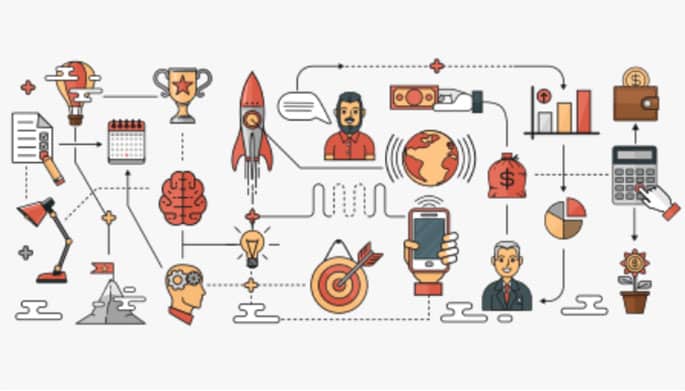Innovation is about creativity, but it is also about strategy. You need to have a plan before you begin this adventure. Below I describe 4 concrete steps towards a winning innovation strategy.
Pioneering businesses need people who are creative. Without Steve Jobs and Steve Wozniak, there wouldn’t have been Apple; without Elon Musk, there wouldn’t have been a SpaceX. On the flip side, Jobs and Musk wouldn’t have succeeded without strategic planning and business savvy.

The beautiful thing is strategic planning is the part of successful innovators that you can learn yourself. Below, I give you tactics how to use strategic planning to win the innovation battle.
1. Explore the Market
“Look before you leap” is one of the wisest maxims in the English language. As a reader of this blog, you are probably a creative person. Instead of just beginning to build a new product, though, it is better to explore the market first. By doing that, you will recognize new opportunities and potential disruptions.
Particularly, you have to find the answers to questions such as:
- Is there a new player in your market that is taking away the juiciest bits?
- Is customer behavior changing? What does this tell you about their needs and wishes?
- Are technological innovations or new laws/regulations changing your market, and what new customer wishes are resulting from that?
Case Study: Ovo Energy
Ovo Energy is a small British energy supplier that wanted to grow. Market research identified a widespread, unmet need for a new brand to challenge the so-called “Big Six” in the energy market as well as a need for lower prices.

Hence, promising an annual energy bill under £1,000 became the core of Ovo Energy’s new service proposition, and it resulted in a three-fold increase in the number of customers.
2. Form a Cross-functional Team
Innovation should inform your whole organization. That is why you should form a cross-functional team—a group of people with different functional expertise working toward a common goal.
The results will be positive: different outlooks on problems and support for innovation in every part of your business.
Case Study: Nike
Sportswear company Nike’s technological arm “aggressively innovates solutions to drive growth while creating and implementing tools that help make everything else in the company possible,” as they put it themselves.
To accomplish this, they work in cross-functional teams consisting of IT architects, lead engineers, and delivery leaders. The results are amazing: many innovations and huge earnings.

3. Embrace the Constant Feedback Loop
Customer behavior indicates how products are used. It tells you something about wishes of your customers that may or may not be met. Through data analytics solutions, you can explore this behavior and derive insights from it.
Moreover, customer data can reveal:
- the time of day customers buy your product the most;
- the correlation between demographic characteristics and preferred products;
- the extent to which individual customers are being influenced by discounts.
Case Study: Instagram
My colleague Matthijs Rosman describes in a blogpost the birth of Instagram as we know it. Starting as a location-based social network called “Burbn,” the app was well received. Attracting new users was much harder though.
Looking into the user data, developers found out Burbn was mostly used for sharing photography. So, the app was stripped of most of its extraneous features and was renamed “Instagram.”
4. Create a Minimal Viable Product
Building a minimum viable product (MVP) is a great way to test your product in the market. An MVP is a product with just enough features to satisfy early customers while also providing feedback for future product development. Instead of this, it’s also possible to launch an MVP movie as Dropbox did before launching the real product.
As author Eric Ries puts it, “The minimum viable product is that version of a new product a team uses to collect the maximum amount of validated learning about customers with the least effort.” Gathering insights from an MVP is often less expensive than developing a product with more features.

Case Study: LinkedIn
There is a famous quote by Reid Hoffman, the founder of LinkedIn, which really resonates with many entrepreneurs: “If you are not embarrassed by the first version of your product, you’ve launched too late.”
In late 2002, Reid Hoffman formed a team of former colleagues from Socialnet and PayPal to build the first version of LinkedIn which was launched within only half a year. This MVP offered only professional profiles and a feature to invite other people to your network.
First users complained that they could not find people outside their own network and profiles weren’t open to the public. This feedback was used by the team to improve the product over and over again to what it has become today. Some of these new improvements included features such as upload your own address book, synchronize your calendar, participate in groups, find sales leads, etc., etc., etc.
Never Stop Innovating
Even if you have already implemented these steps, your work is not done. On the contrary, you continue to make improvements to your product portfolio through unceasingly testing. I can’t give you a guarantee your business will prosper as a result, but by continuously focusing on innovations and iterations, you certainly will have a fighting chance in the innovation battle.
Jeroen van der Vlugt
Recognized as a trusted advisor. Expert in stakeholder management in complex (political) environments. Specialist in issues at the intersection of business and technology. Also competent in developing and implementing the right sourcing strategy.
Related posts
Strategies to counter disruption or to become a disrupter yourself
We see the same things happening in the business world.…
January 7, 2021
Early warning signals for disruption
Any industry can be disrupted. Netflix is a famous example.…
December 15, 2020
The Great Reset: Disrupt Or Be Disrupted
We live in times of unprecedented change. In order to cope…
December 3, 2020



